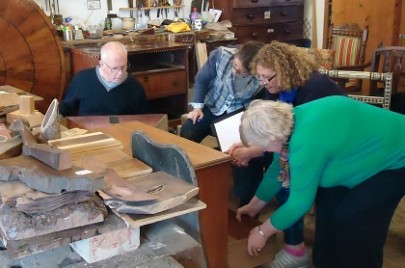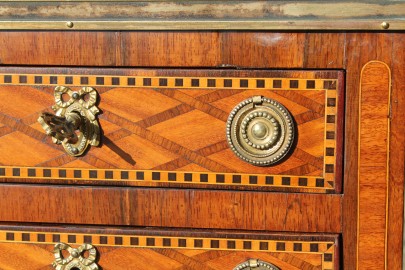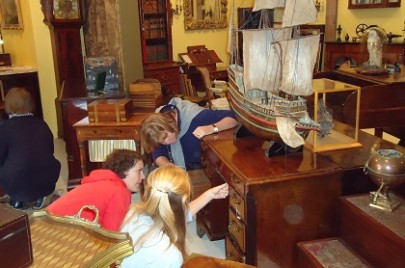Woodwork at school, the only subject I was interested in, the natural impetus that catapulted me towards restoring antique furniture. I learned my craft and trade skills with various professionals in my travels through Europe and elsewhere, before returning to Scotland and starting my own business.
At a dinner party many years later, sitting next to a glamorous girl – a woman with a dilemma – tell me more! Just bought a house in Perthshire. Ten rooms to fill, hence plenty of space for new things (and old).
She had the task of making the house into a home with the support of a very large company cheque book.
Her real problem was the daunting task of visiting antique shops and entering into the world of auction houses, knowing little or nothing of the subject.
I mentioned my furniture restoration and identification course ideals - the seed germinated and have proven extremely rewarding to both client and myself.
Being a restorer with hundreds of furniture items dismantled, made good, reassembled and found good homes. I am still astounded how items constructed conceived and restored hundreds of years ago have survived the passage of time.
Just recently a fantastic longcase clock dated back to about 1670’s came in. Crossbanded in olive wood with matching oyster veneers, small marquetry panels, showing the extra skill which made it exquisite. The marquetry was well conceived, not too fussy with native woods; some stained as was some bone inlay which gave it that extra bit of class. The case proportions were to die for, precise engineered to fit the movement and the pendulum arc. One can only look on such perfection with wonder, awe and admiration.
We restore many astounding things and I am still overwhelmed by one or two items every year. Of course many have some scars, if they don’t we would wonder what was wrong!
Wood! What wood is a person’s prize possession made of? One of the most frequently asked questions. A lightish wood! I suggest pine or satinwood if quality. Neither! An eventual house visit revealed the lightish wood was mahogany! Yes wood is an enormous and fascinating subject. Examination may reveal drawer linings made of an unusual wood, indicating a certain part of the country, or made abroad to a British design.
Provincial cabinetmakers might not have had access to some exotic woods and had to make do with what they had.
Characteristics of wood can date furniture; for example West Indian satinwood arrived in the country before East Indian satinwood and can help determine an 18-century piece.
Styles of furniture can also be hard to understand. An early oak joint stool could be made in the style of the 16-century but made yesterday. Dating furniture like this can be difficult to decide a specific decade without handling both an original and modern piece. Signs of shrinkage, saw marks, pegging, general wear and tear can be seen on a good practical course- I cannot think of any other solution.
Transformed furniture can be misleading, plenty in the market! Victorian tables converted into bedside cabinets, commodes to hide the TV. The list is endless and sometimes not easy to spot the original. The better the transformation the harder to spot especially if old materials have been used. Not fakes but transformations to increase market value, sometimes successfully-sometimes not!
Fakes - a different ball game, items made to deceive. I have bought some and don’t care, if the craftsmanship is as good as the original when it was made, then the inherent value will appreciate as a long-term investment. To produce modern quality takes patience, skill and knowledge all worth paying the price for, provided you are aware of what you are buying. The labourer is still worthy of his hire- the craftsman of his skill.
Look for signs of identification. Old labels may give details of the maker, retailer, shippers and the place of origin. They can be found in the most out of the way situations – under drawer bases, backboards, dislodged in the most unlikely places – a well gnawed example formed part of a mouse nest!
Impressed marks on the carcasses can reveal a maker often on the top of a drawer or door. Maker’s stamps on furniture were employed far more on the continent that ever in Britain. I find it quite disappointing seeing fabulous pieces but we have no idea what skilled craftsman made the piece.
While I was training in France I remember getting all the French in the workshop to stop for the British custom of tea at 5pm. It was on one of these occasions we were admiring a very fine Louise XV chair. The proportions were marvellous, beautiful flowing cabriol legs and carved arms, infact none of the wood was straight everything finely shaped.
As the light fell on the chair someone noticed two very faint letters, this ended up being all that was left of a maker stamp. With a little research we found the probable maker. In most instances the price will be greatly enhanced. Tea breaks can we worthwhile!
Marks can also be found on handles, under brass decoration, particularly locks and clock movements. Behind a clock dial can ever show repairers dates and names, even visits to the pawnshop. Painted clock dials held at various angles to catch the light could reveal the maker’s name if an ultra violet light is not available.
Seek and Ye shall find – you could be quid’s in!
Being a craftsman I appreciate good work. Every year that goes by we are loosing more skills and restorers are now expected to do the work of 18-century workshop artisans, carvers, guilders, cabinetmakers, veneer’s, polishers to name a few.
The antique profession I still find fascinating, whatever our field or interest, we can all continue to learn.
Once speaking to a fine art dealer I asked if he ever bought furniture - no he replied - I have no idea what I’m buying! Where does that leave the public?
I personally buy a varied amount of things whether it be porcelain for my own house or a painting. Once I remember visiting a fine art sale filling in time, a client of mine was there and she said with paintings one needs to fall in love-it’s simple! I agree too.
With works of art if one feels it is worth the price and one can afford it – buy it!
I have often been into an antique shop or sale and come out with something completely different. I do try and look at everything however unknowledgeable one is, always something to learn! I have made mistakes and will make more, normally if all else fails I end up putting the item back into another sale, hopefully not loosing money.
My glamorous dinner companion did sign up for a three day course deciding wisely as it turned out a little knowledge may be dangerous but better than none at all!
Once it is accepted there is something to learn we can educate our eye to recognize quality and proportions. Now the real detective work starts in a real workshop. Clients can be as diverse as the twenty or so pieces of furniture.
Quote “ I really did not like that bit of furniture when I arrived but now I really appreciate it for what it is.”
What did it cost again?

I was persuaded to do a one-day study day for the Perthshire NADFAS in the antique restoration workshop where I run my business. Having initially been persuaded, I did not think too much about it. A bit like some jobs we take on, say yes, and then work out what you’re going to do nearer the time.
Well, those were exactly my thoughts here. As the time got nearer I decided on a slow tour around the workshop explaining some of the jobs in process and see how it goes. Slightly daunted by the prospect I did get some bullet points down on paper the night before.
I was very encouraged that the course was booked up in a very short period of time, with a huge waiting list. People are interested in artists and craftsmen who restore fine antique furniture in this Ikea period we live in.
I sometimes wonder whether what we do, goes completely unnoticed with very few people interested in learning the profession. I was thrilled with the general interest of the different NADFAS groups over the three days, as I talked about different sorts of wood and how you can recognise them by their particular features. I also explained how veneers were cut and employed over the centuries. As you start to understand wood you must also understand some of the history surrounding when it was used. Knowing when walnut, mahogany and other woods started to arrive in the country is also an important part.
How can you have a mahogany 17th Century Lowboy if mahogany was still happily growing in Cuba? The answer is you cannot - it must be something else, or, it is not from that period.
The NADFAS one-day course was a first for me. I think everyone left with their heads buzzing with information and new eyes when it comes to observation. I feel there is a lot to learn and the spiel was coming thick and fast. I heard someone say later “I wish I’d taken notes but then I would have missed out on the next bit of information.”
We looked around the workshop and saw all the different pieces in the process of restoration and conservation and I explained some of what we were doing. For example, the marquetry cutting on an Edwardian card table, where pieces had been lost and we had to design the missing areas. Flower vases on furniture – what a mess they can make, but that keeps us busy.
We also looked at a wonderful Queen Ann walnut bureau bookcase of fantastic quality in desperate need of a bit of love and care. The restoration of items like this are treated with utmost care and admiration. I’m very conscious that the beautiful bleached lustre of years of patina must be preserved at all costs. Unfortunately this has not always been the case, with furniture badly restored in the past and finishes destroyed that can never be recovered.
As it says on the workshop wall, “the bitterness of poor quality lives long after the sweetness of a cheap price is forgotten.”
I am always amazed how people in the 18th Century and earlier made pieces to such an excellent standard of craftsmanship, which few could repeat nowadays.
Little did anyone know that later in the day that I was going to set a test. This was in fact splitting everyone into groups and asking them to analyse three different pieces of furniture. The challenge was to work out woods used, date, changes, observations and then arriving with a conclusion. Of course every example was different, with a bottle to anyone who got everything right. No one did – so I kept the bottle!
This expertise of examining furniture is what gets everyone thinking and is the most fun. The detective work in recognising if something is hand-sawn or machine-sawn all helps in dating items.
All courses went well with participants keenly interested in learning more. I believe more NADFAS members will be back before too long. Some mentioned a longer course was in order to allow more to sink in and more time to examine lots of other furniture.
In fact I started the three-day antique furniture recognition courses about two years ago. At first I thought what an earth am I going to talk about for three days, then quickly realised the subject is huge and little details that I take for granted, having worked in the profession for 18 years, are not something you can pick up quickly. It has involved years of observation, which now I realise does not grow on trees.
I have had people on courses from all corners of the country and all different walks of life. From the Art and Antiques unit of Scotland Yard, antique dealers from different fields, collectors, guides of stately homes, farmers and many other enthusiasts including a helicopter pilot.
It was a great pleasure having everyone here and how enthusiastic everyone was. Must thank the parents as we ate lunch at their house, as I don’t have a dining table big enough.
Jeremy Gow is a proud full member of the British Antique Furniture Restoration Association (BAFRA), a national organisation of craftsmen and women, setup in 1979 to maintain the high standard in conservation and restoration. Jeremy is one of only four accredited members of BAFRA in Scotland, also listed in the Conservation Register run by UKIC in association with Historic Scotland.

By Jennifer Harper
Have you ever bought a ‘bargain’ in an antique shop only to get it home and realise, under closer inspection, that it’s not quite as original as you first thought? This annoyance at being had, often by likeable Lovejoy rogues, is what is driving people from all over the country to Forfar!
On the outskirts of the Angus town you can find a small army of people in a converted barn, plotting their next visit to the auction house or antique shop. The commander-in-chief is Jeremy Gow, a respected dealer and antique furniture restorer. For the past 18 months Jeremy has been teaching members of the public how to date furniture, recognise period styles and markings, spot fakes and appreciate craftsmanship.
“The aim is to give people the knowledge and confidence to invest in antiques and to teach them how to appreciate fine furniture, whether it be in an auction room, their own house or a stately home,” says Jeremy.
His three-day course, aptly called ‘Know Your Antiques’, is held in the converted barn that he also uses as his restoration workshop. This allows him to use furniture being restored as hands-on examples for his students. This is the only course of its kind in the country and, as a result, people from all over the UK travel to Forfar to increase their antique know-how. Ironically, it is not just Joe Public antique enthusiasts who sign up, but also dealers, serious collectors, upholsterers, auctioneers and, recently, three members of Scotland Yard.
Andrew Bain, a farmer from Longforgan, attended one course and was astounded at the mix of people as well as the wealth of information he gleaned.
“There were two ladies from Wales,” he says. “They make tapestries and needed to learn more about the pieces they were re-covering. I was amazed to find people from all walks of life. I have been collecting antiques for around 40 years but Jeremy showed me that you are never too old to learn. Now when I go round shops or auction houses I can identify the wood that has been used on furniture. At the start of the course Jeremy showed us two clocks and asked which was the most expensive. The one that I would not have given houseroom to was actually worth thousands. When Jeremy pointed out the details we could see it was an amazing clock – but before that I wouldn’t have given it a second glance.”
So where do you start when trying to date or identify a piece of furniture?
“Wood,” exclaims Jeremy. “Wood is an enormous subject. Examination of a piece may reveal drawer linings made of an unusual wood, indicating a certain part of the country, or made abroad to a British design. Provincial cabinetmakers might not have had access to some exotic woods and had to make do with what was available. The characteristics of wood can date furniture – for example, West Indian satinwood arrived in the country before East Indian satinwood, so that can help determine an 18th century piece.”
He adds: “Styles of furniture can also be hard to understand. An early oak joint stool could be made in the style of the 16th century but made yesterday. Dating furniture like this can be difficult to achieve without handling both an original and modern piece, which is what we do on the course. When comparing pieces, my students can see signs of shrinkage, saw marks, pegging and general wear and tear. Of course, many pieces have some scars, but if they didn’t we would wonder what was wrong.”
Signs of identification, such as a maker’s label, can also solve unanswered questions. Old labels often show the names of the maker, retailer, shipper and place of origin. And Jeremy advises looking in less obvious places – under drawer bases and backboards – to find them. Impressed marks may also be found on the carcass, perhaps on top of the door, drawer or even under a brass decoration, again identifying the maker.
But, what about fakes? Everybody hates to feel they have been done. Would Jeremy ever knowingly buy reproduction furniture?
“I have bought some and I don’t care, if the craftsmanship is as good as the original then the inherent value will appreciate as a long-term investment,” he says. “To produce modern quality takes patience, skill and knowledge – these are all worth paying for, provided you are aware of what you are buying.”
It was the doubt in knowing what she was buying that inspired Veronica Hill, a retired nursing tutor from Melrose, to join Jeremy on the course.
“I did not have a great knowledge of antiques and I have really had to take it on trust that whoever I was buying from was a bona fide person,” admits Veronica. “I really wanted to know more about what I was looking at. Having done the course I now have an insight into period furniture. Jeremy stimulated my interest in the marriage of furniture, where you take a piece of furniture and marry it up with another piece, making it more functional for today’s living. It works very well and I am planning to put that into practice. I can now also identify period details and additions, and generally feel more confident when buying at auction.”
Caroline Robertson, a property manager from Edinburgh, agrees. “I had an awareness of antiques and an interest but not any real knowledge. Up until now I would wander into an auction house or antique shop and not have a clue what I was looking at. The antique world is such a vast subject and I could never be an expert, but at least I now have a better feel for what I am looking at.”
The antiques industry is indeed a minefield when first entering, but even the experts get it wrong sometimes. There will always be someone out there trying to pull off a scam, but with a little extra knowledge it is clear that we could save ourselves some money and heartache. Having said that, the old cliché of ‘it is only worth as much as you are prepared to pay for it’ still stands.
Jeremy says: “A while ago I was speaking to a fine art dealer and I asked if he ever bought furniture. He said ‘no, I have no idea what I’m buying’. Where does that leave the public? I personally do buy a varied amount of things, whether porcelain for my own house or a painting. At a recent fine art sale a client told me that with paintings one needs to fall in love. I agree. With works of art, if you feel it is worth the price and you can afford it, then buy it. I have made mistakes and am sure I will make more. It is all a matter of educating our eye to recognise quality and proportions. I still get astounded how items constructed hundreds of years ago have survived the passage of time.”

Written by Sarah Loather
Many of us may have seen the TV programme “Lovejoy” about the lovable rogue involved in the antique business, and many of us may have come across Lovejoy characters through the course of our lives.
Increasingly the antiques trade has come across for public scrutiny and derision particularly when we learn that some of the larger international auction houses haven’t been able to tell their George III’s from a very elegant piece of furniture from the various Reproduction Centres across the country.
Some of us are becoming more savvy, questioning evaluators and vendors. And with people’s confidence in equities shattered, more of us are looking at investing our money in something tangible, which is both useful, beautiful and appreciates in value.
Well last year when I was in Forfar I met the smashingly talented Jeremy Gow who is one of only three members of the British Antique Furniture Restoration Association (BAFRA) in Scotland. With eighteen years’ experience in the trade, he works for many stately homes throughout Scotland and private clients including the owner of a £55m “gin palace” boat in Monaco.
He took me round his Forfar workshop and really put me through the mill “How old do you reckon this is Sarah?”, “What type of wood is this?” “How much would you pay for this?” I was clueless, but I was distracted by the masses of fire and water damaged articles Jeremy had been given to restore. Well that was my excuse.
Jeremy is increasingly irritated at the public getting ripped off…. “auction houses have noticed an increasing number of private buyers at sales over the last five years…people feel they are getting more of a bargain at auctions. But if you take away something you thought was 18th century and later find its 19th century – you have no recourse. At least at an antique shop you can take it back”.
In fact the auction houses in Edinburgh have noticed a drop off in demand for household sale furniture, but a marked increase in prices and demand for fine ‘investment grade’ furniture.
So, with that in mind Jeremy is starting the first course of its kind in the country dedicated to antique furniture recognition. “The aim is to give people the knowledge and confidence to invest wisely in antiques, which in many cases outperformed the stock market and to teach them to appreciate fine furniture”.
Jeremy ran three courses at the end of 2001. Participants ranged from 28-77 years old from the curious to former National Trust employees.
“There are millions of fakes out there in the market”, added Jeremy. “It’s quite a minefield”.
Three days cost £295 + vat which includes lunch with wine. The course not only covers understanding wood, dating furniture, learning styles to identifying fakes, but Jeremy promises me secrets of the trade are revealed and tips given on bidding at auction.
This may be the first of its kind in the country, but I have no doubt Jeremy’s courses will inspire others to run their own courses. Will this see the demise of ‘Lovejoys’? I doubt it, so now’s the time to play the ‘experts’ at their own game.

A non-refundable deposit of £100 is required to reserve a place, with the balance payable four weeks in advance of the course. To register for a course please contact us
Our courses have been attended by the Art and Antiques Unit of Scotland Yard, antique dealers from all different fields from all over the globe, collectors, and guides of stately homes, farmers, and many other enthusiasts including a helicopter pilot! Our youngest participant was 19 and our eldest has been 84 so everyone is very welcome!







